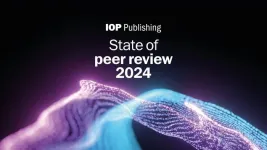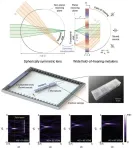(Press-News.org) Artificial intelligence (AI) computer programs that process MRI results show differences in how the brains of men and women are organized at a cellular level, a new study shows. These variations were spotted in white matter, tissue primarily located in the human brain’s innermost layer, which fosters communication between regions.
Men and women are known to experience multiple sclerosis, autism spectrum disorder, migraines, and other brain issues at different rates and with varying symptoms. A detailed understanding of how biological sex impacts the brain is therefore viewed as a way to improve diagnostic tools and treatments. However, while brain size, shape, and weight have been explored, researchers have only a partial picture of the brain’s layout at the cellular level.
Led by researchers at NYU Langone Health, the new study used an AI technique called machine learning to analyze thousands of MRI brain scans from 471 men and 560 women. Results revealed that the computer programs could accurately distinguish between biological male and female brains by spotting patterns in structure and complexity that were invisible to the human eye. The findings were validated by three different AI models designed to identify biological sex using their relative strengths in either zeroing in on small portions of white matter or analyzing relationships across larger regions of the brain.
“Our findings provide a clearer picture of how a living, human brain is structured, which may in turn offer new insight into how many psychiatric and neurological disorders develop and why they can present differently in men and women,” said study senior author and neuroradiologist Yvonne Lui, MD.
Lui, a professor and vice chair for research in the Department of Radiology at NYU Grossman School of Medicine, notes that previous studies of brain microstructure have largely relied on animal models and human tissue samples. In addition, the validity of some of these past findings has been called into question for relying on statistical analyses of “hand-drawn” regions of interest, meaning researchers needed to make many subjective decisions about the shape, size, and location of the regions they choose. Such choices can potentially skew the results, says Lui.
The new study results, publishing online May 14 in the journal Scientific Reports, avoided that problem by using machine learning to analyze entire groups of images without asking the computer to inspect any specific spot, which helped to remove human biases, the authors say.
For the research, the team started by feeding AI programs existing data examples of brain scans from healthy men and women and also telling the machine programs the biological sex of each brain scan. Since these models were designed to use complex statistical and mathematical methods to get “smarter” over time as they accumulated more data, they eventually “learned” to distinguish biological sex on their own. Importantly, the programs were restricted from using overall brain size and shape to make their determinations, says Lui.
According to the results, all of the models correctly identified the sex of subject scans between 92% and 98% of the time. Several features in particular helped the machines make their determinations, including how easily and in what direction water could move through brain tissue.
“These results highlight the importance of diversity when studying diseases that arise in the human brain,” said study co-lead author Junbo Chen, MS, a doctoral candidate at NYU Tandon School of Engineering.
“If, as has been historically the case, men are used as a standard model for various disorders, researchers may miss out on critical insight,” added study co-lead author Vara Lakshmi Bayanagari, MS, a graduate research assistant at NYU Tandon School of Engineering.
Bayanagari cautions that while the AI tools could report differences in brain-cell organization, they could not reveal which sex was more likely to have which features. She adds that the study classified sex based on genetic information and only included MRIs from cis-gendered men and women.
According to the authors, the team next plans to explore the development of sex-related brain structure differences over time to better understand environmental, hormonal, and social factors that could play a role in these changes.
Funding for the study was provided by the National Institutes of Health grants R01NS119767, R01NS131458, and P41EB017183, as well as by the United States Department of Defense grant W81XWH2010699.
In addition to Lui, Chen, and Bayanagari, other NYU Langone Health and NYU researchers involved in the study were Sohae Chung, PhD, and Yao Wang, PhD.
Media Inquiries:
Shira Polan
Phone: 212-404-4279
shira.polan@nyulangone.org
END
Artificial intelligence tool detects sex-related differences in brain structure
Findings highlight need for diversity in neurological and psychiatric research
2024-05-14
ELSE PRESS RELEASES FROM THIS DATE:
A bionanomachine for green chemistry
2024-05-14
Researchers at the Paul Scherrer Institute PSI have for the first time precisely characterised the enzyme styrene oxide isomerase, which can be used to produce valuable chemicals and drug precursors in an environmentally friendly manner. The study appears today in the journal Nature Chemistry.
Enzymes are powerful biomolecules that can be used to produce many substances at ambient conditions. They enable “green” chemistry, which reduces environmental pollution resulting from processes used in synthetic chemistry. One such tool from nature has now been characterised in detail by ...
How wildfires change soil chemistry
2024-05-14
The huge, long-lasting wildfires that have become increasingly common in recent years can cause changes in soil chemistry that affect water contamination, air quality, and plant growth. But these changes are poorly monitored and rarely factor into post-fire recovery efforts or risk assessments, according to a review study published May 14 in Nature Reviews Earth & Environment.
The study, led by Stanford University and Colorado State University scientists, found that better techniques are needed to monitor changes in soil and surrounding ecosystems. This enhanced ...
Genes driving age-related blood cell mutations uncovered
2024-05-14
Scientists have discovered 17 additional genes that drive the abnormal overgrowth of mutated blood cells as we age. The findings, published today (14 May) in Nature Genetics, provide a more complete view of the genetic factors behind clonal haematopoiesis – a process associated with ageing and linked to increased risks of blood cancers1.
Researchers from the Wellcome Sanger Institute, Calico Life Sciences, California, and the University of Cambridge analysed sequencing data from over 200,000 individuals in the UK Biobank cohort. They searched for genes showing signals of "positive selection" – where mutations ...
WASP-193b, a giant planet with a density similar to that of cotton candy
2024-05-14
An international team led by researchers from the EXOTIC Laboratory of the University of Liège, in collaboration with MIT and the Astrophysics Institute in Andalusia, has just discovered WASP-193b, an extraordinarily low-density giant planet orbiting a distant Sun-like star.
This new planet, located 1,200 light-years from Earth, is 50% larger than Jupiter but seven times less massive, giving it an extremely low density comparable to that of cotton candy. "WASP-193b is the second least dense planet discovered to date, after Kepler-51d, which is much smaller," explains ...
IOP Publishing report reveals peer review capacity not used to its full potential
2024-05-14
A new global study from IOP Publishing (IOPP) has found that certain peer review communities continue to feel overburdened by reviewer requests, while others remain underrepresented.
The survey, which generated over 3,000 responses from peer reviewers from across the globe, revealed regional and career-stage disparities:
30% of reviewers from high-income countries indicated that they receive too many peer review requests, compared with just 10% from low and middle-income countries*
Just 6% of respondents from China and 7% from India indicated that they ...
Eco-friendly and affordable battery for low-income countries
2024-05-14
A battery made from zinc and lignin that can be used over 8000 times. This has been developed by researchers at Linköping University, Sweden, with a vision to provide a cheap and sustainable battery solution for countries where access to electricity is limited. The study has been published in the journal Energy & Environmental Materials.
“Solar panels have become relatively inexpensive, and many people in low-income countries have adopted them. However, near the equator, the sun sets at around 6 PM, leaving households and businesses without electricity. The hope is that ...
New transit station in Japan significantly reduced cumulative health expenditures
2024-05-14
The declining population in Osaka is related to an aging society that is driving up health expenditures. Dr. Haruka Kato, a junior associate professor at Osaka Metropolitan University, teamed up with the Future Co-creation Laboratory at Japan System Techniques Co., Ltd. to conduct natural experiments on how a new train station might impact healthcare expenditures.
JR-Sojiji Station opened in March 2018 in a suburban city on the West Japan Railway line connecting Osaka and Kyoto. The researchers used a causal impact algorithm to analyze the medical expenditure data gathered from the time series medical ...
USC study reveals racial disparities in diagnosis and drug use for dementia symptoms
2024-05-14
Compared to Black and Asian people, white and Hispanic people with Alzheimer’s disease and related dementias were most likely to be diagnosed with symptoms like depression and agitation, according to a new study from the USC Schaeffer Center for Health Policy & Economics.
White and Hispanic people with these diagnoses were also most likely to be prescribed central nervous system (CNS) active drugs, including antidepressants, antipsychotics and anticonvulsants. Yet, these drugs have been associated with higher risk of falls, cardiovascular events, hospitalization and death, according to the study published today in the Journal of Alzheimer’s ...
Metalens expands Its reach from light to sound
2024-05-14
Junsuk Rho from the Department of Mechanical Engineering, the Department of Chemical Engineering, and the Department of Electrical Engineering, Dr. Dongwoo Lee from the Department of Mechanical Engineering, and Beomseok Oh, a PhD student, from the Department of Chemical Engineering at Pohang University of Science and Technology (POSTECH) have achieved a breakthrough in surpassing the limitations of traditional acoustic metalenses. They have successfully developed the first wide field-of-hearing metalens. This research has been recently published in the international journal, Nature Communications.
Sound ...
Ultrasensitive gas detection empowered by synergy of graphene and sub-comb dynamics
2024-05-14
Since the inception of microcomb, whose generation relies on Kerr nonlinearity in microresonator, the coherent soliton state has attracted intense researches. Although the operation of sub-comb outputs is straightforward, as noncoherent comb state, it was often overlooked in previous techniques. With graphene sensitization, this sub-comb heterodyne sensing device exhibits an exceptional response to gas molecular adsorption, achieving detect limits of 1.2 ppb for H2S gas and 1.4 ppb for SO2 gas, respectively. In summary, our research synergizes flexible ...
LAST 30 PRESS RELEASES:
Making lighter work of calculating fluid and heat flow
Normalizing blood sugar can halve heart attack risk
Lowering blood sugar cuts heart attack risk in people with prediabetes
Study links genetic variants to risk of blinding eye disease in premature infants
Non-opioid ‘pain sponge’ therapy halts cartilage degeneration and relieves chronic pain
AI can pick up cultural values by mimicking how kids learn
China’s ecological redlines offer fast track to 30 x 30 global conservation goal
Invisible indoor threats: emerging household contaminants and their growing risks to human health
Adding antibody treatment to chemo boosts outcomes for children with rare cancer
Germline pathogenic variants among women without a history of breast cancer
Tanning beds triple melanoma risk, potentially causing broad DNA damage
Unique bond identified as key to viral infection speed
Indoor tanning makes youthful skin much older on a genetic level
Mouse model sheds new light on the causes and potential solutions to human GI problems linked to muscular dystrophy
The Journal of Nuclear Medicine ahead-of-print tip sheet: December 12, 2025
Smarter tools for peering into the microscopic world
Applications open for funding to conduct research in the Kinsey Institute archives
Global measure underestimates the severity of food insecurity
Child survivors of critical illness are missing out on timely follow up care
Risk-based vs annual breast cancer screening / the WISDOM randomized clinical trial
University of Toronto launches Electric Vehicle Innovation Ontario to accelerate advanced EV technologies and build Canada’s innovation advantage
Early relapse predicts poor outcomes in aggressive blood cancer
American College of Lifestyle Medicine applauds two CMS models aligned with lifestyle medicine practice and reimbursement
Clinical trial finds cannabis use not a barrier to quitting nicotine vaping
Supplemental nutrition assistance program policies and food insecurity
Switching immune cells to “night mode” could limit damage after a heart attack, study suggests
URI-based Global RIghts Project report spotlights continued troubling trends in worldwide inhumane treatment
Neutrophils are less aggressive at night, explaining why nighttime heart attacks cause less damage than daytime events
Menopausal hormone therapy may not pose breast cancer risk for women with BRCA mutations
Mobile health tool may improve quality of life for adolescent and young adult breast cancer survivors
[Press-News.org] Artificial intelligence tool detects sex-related differences in brain structureFindings highlight need for diversity in neurological and psychiatric research





